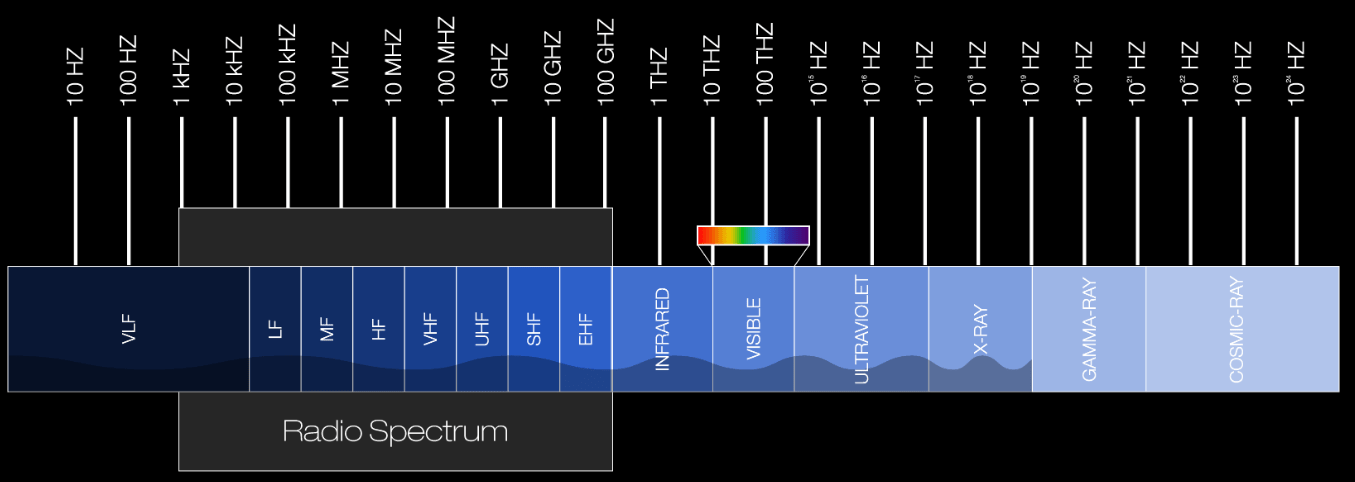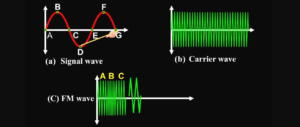- What are the elements of communication systems? Explain with classifications of communication systems
- What is the Frequency Spectrum of Communication Systems? Why Modulation is necessary in wireless transmission?
- What is Amplitude Modulation? Complete Mathematical Derivation of AM Wave
- What is the Importance of Side Bands in Amplitude Modulation? What are the types of AM?
- What is Frequency Modulation? Explain the process with diagram and mathematical analysis
- What is Satellite communication? Give Detailed explanation with diagram and mathematical analysis
We shall discuss in this article about the Frequency Spectrum of Communication Systems? Why Modulation is necessary. When signal is transmitted over an antenna, it is first converted into equivalent electromagnetic waves and after that the electromagnetic waves detach from antenna and travel into free space. The artist’s impression of electromagnetic wave is shown below –

The total range of such frequencies is called as electro-magnetic spectrum. Its frequency is given by the following equation f = c / λ.
Concept of modulation
Amplitude modulation: The process, in which the amplitude of carrier changes in accordance with amplitude of modulating signal, is called amplitude modulation. (i.e. Amplitude changed by amplitude)
Frequency modulation: The process, in which the frequency of carrier changes in accordance with amplitude of modulating signal, is called amplitude modulation. (i.e. Frequency changed by amplitude)
Phase Modulation: The process, in which the phase of carrier changes in accordance with amplitude of modulating signal, is called amplitude modulation. (i.e. Phase changed by amplitude)
Necessity of modulation
To transmit our voice signal over an antenna for wireless communication, we need to calculate the height of antenna.
Suppose we want to transmit, a 3kHz (voice frequency) signal over an antenna. Then the height of the antenna can be calculated using following equation –
height (h) = velocity of light (c) / frequency (f) of signal
i.e. h = (3 × 108) / (3 × 103) = 105 m = 100km
This height of the antenna is practically impossible! However, according to Maxwell’s Law, we can reduce its height up to h/2 to h/16. So for h/16, it becomes approximately 6.2km, which is still practically impossible…!
Therefore, we cannot transmit low frequency signals directly. As per above equation, if we increase frequency of electrical signal then the height of antenna will reduce.
But we want to transmit electrical signals in audio range. And our highest audio frequency is 20kHz. For this, height of antenna will be around 15km.
This height is also impossible!
Hence, there is only one solution on this problem and that is process of modulation. In modulation process, a very high frequency, carrier signal is modulated by low frequency modulating signal. After modulation, low frequency signal rides over carrier signal. This modulated carrier signal is connected to antenna for transmission.
Suppose we modulate a 300MHz carrier signal by a 3kHz modulating signal. Then actually, 300MHz signal is transmitted over the antenna.
So height of the antenna can be calculated in terms of carrier signal, as follows –
height (h) = velocity of light (c) / frequency (f) of signal
i.e. h = (3 × 108) / (300 × 106) = 1m
This height is practically possible! Now modulating signal will be transmitted with carrier signal by riding over it.
We can receive this combined signal at receiver end. In receiver, process of demodulation is used to recover our 3kHz modulating signal (voice signal) and then the carrier signal is bypassed.




Sir, its a very nice writeup! I understood it all, in really a simple way!
I wanted to ask one question, sir, that whether there is any other type of modulation, excluding modulated and baseband?
Please reply.